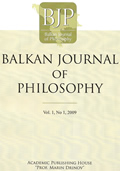From Logo-Kosmos to Techne-Kosmos in the Ontology of the Human
From Logo-Kosmos to Techne-Kosmos in the Ontology of the Human
Author(s): Mihai D. VasileSubject(s): Philosophy
Published by: Институт по философия и социология при БАН
Keywords: logos; reason; kosmos; science; evil; model theory; myth of mega-machine; God; Golem;
Summary/Abstract: The author tries to prove that Plato’s theory of the creation of kosmos by Demiourgos as conforming to a pre-existing model – namely “ho LÍgos” – by way of the possession of a peculiar art, i.e. “to-know-how”, has a contemporary correspondent in the image built by science of the universe. Even the emergence of evil in such a rational and ordered universe has a replication in the religious myth of Lucifer’s rebellion. The paper is intended to show that, in the history of post-modern culture, three periods of global life are known as characterized through the connection between science, philosophy and religion. The first is described in the dialogue Timaeus, where Plato imagined the creation of the world by Demiourgos, according to the Logos: “Cosmos was forged by a model – Logos – which can be designed with reason – Nous”; “Once he saw that the universe is moving and living, born as holy habitation of the immortal gods, begotten of the Father who was seized by delight and rejoicing. He had thought about how to make it even more like the model – Logos. And how this model – Logos – is an eternal creature, Demiourgos tried to perfect the universe, in this regard also”; “He has made a smooth body, uniform and equal everywhere from centre, whole and absolutely right-down, composed of perfect bodies”. Ptolemy, drawing on an Aristotelian conception of time and eternity, developed, in his Almagest, a vision of the cosmos founded on the ideas of Aristotle’s Physics describing a geocentric universe full of symbols. But this universe could not be brought to the eye as improved, as a universal astronomical system limited by the firmament of the fixed stars beyond which Christian theology has placed Paradise and Hell. The second period can be described through what Max Weber says about modernity, a process of “Entzauberung der Welt”, dramatically accelerated since the scientific revolution of Galileo, accomplished by the globalization of the mechanistic empire, by replacing Aristotelian and Thomist space, which is closed, limited and heterogeneous, by a homogeneous infinite space. Meta-science that favoured the emergence of modern scientific revolution is related to the logos problem of evolution and its solutions, where the core terminology means equally reason, rationality, science, and at the same time speech, word, verb, having religious or transcendent connotations but secularised in an historical horizon. The contemporary period – the third, the end of the second and the beginning of the third millennium – is placed under the heresy of the solidarity between science and technology, characterized by the technefication of science designating a process whereby techniques are predominant in traditional research methods, opening an age of cybernetic heresy.
Journal: Balkan Journal of Philosophy
- Issue Year: VI/2014
- Issue No: 1
- Page Range: 59-64
- Page Count: 6
- Language: English

